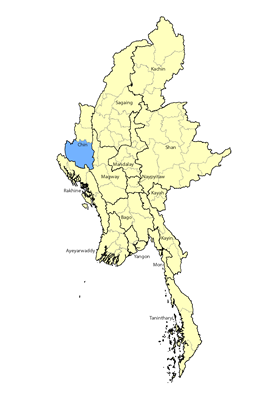The Eastern Khumi, who are also known as the Khami (“village people”), are linguistically different from other Khumi people. Over the years, Eastern Khumi became a cover term for researchers listing various loosely affiliated people groups, so that today linguists name as many as 15 dialect groups under the banner of “Eastern Khumi Chin,” even though most of those groups have their own ethnic name, history, customs, and sense of group identity. In Operation Myanmar, the Asang Khongsa, Khawngtu, Lemi, Likhy, and Rengca tribes have all been profiled separately. The folly of lumping divergent groups together under one banner is seen in this 2011 report by the Bible translation ministry SIL: “The Nisay, Lemi, and Likhy groups are currently working on language development. Almost all the Eastern Khumi people expressed considerable interest in having a Bible translation in their own varieties. They do not seem very willing, however, to use another group's literature.”
Location: Boasting a population of 14,000 people, the Eastern Khumi inhabit approximately 90 villages of Chin State in the westernmost part of Myanmar. All live within Paletwa and Matupi townships, with the highest concentration of 85 villages found in and around the town of Sami. The Eastern Khumi area is bordered by Bangladesh to the west, India to the north, and Rakhine State to the south.
Language: Although the various “dialects” of Eastern Khumi are related to various degrees, similarities are often too few to enable smooth communication between the different tribes. The authoritative Ethnologue says: “These dialect groups do not have a unified identity or overarching name for themselves. However, because their speech varieties are highly intelligible with each other and because they are referred to as ‘Nisay' (eastern groups) by the Khumi, the term Eastern Khumi is used as a cover term to refer to these groups.”
The Khumi claim to have been one of the first Chin tribes to migrate from the north, but the group was divided when they “passed through big mountain ranges and moved west, leaving women and children to come behind. The advance party cut down plantain trees to mark their trail, but when the slower group arrived, they found only growing plantain trees. They assumed the advance group had already gone far beyond, so they decided to camp and plant rice. Thus, the two groups lost each other.” The Eastern Khumi fought the British throughout the 19th century, “but their spears and bows and arrows were no match against the British rifles, and the British took over the southern part of the Paletwa area, opening an outpost there in 1826.”
The Eastern Khumi and other Chin tribes are known for their warm hospitality, which was woven into their identity long before they became Christians. Their code of moral conduct “made it obligatory for every person to be courteous, considerate, unselfish, courageous, industrious, and willing to help others even at considerable inconvenience to oneself. If anyone was hungry, a man would eat very little, leaving the bigger portion of food for his friends.”
The Eastern Khumi were traditionally animists with a smattering of Buddhists among them until 1929, when the Bible Churchmen's Missionary Society sent H. Hacking and his wife, accompanied by nine Mizo evangelists, to engage the Eastern Khumi. As a result, “several converts were won, and one of the evangelists had a little bamboo church with a congregation of about 20 believers.”
Christian influence continued to grow throughout the 1930s and beyond as the power of the Gospel transformed lives and entire villages. Today almost all Eastern Khumi are Christians, meeting in churches established by at least a dozen denominations. The Eastern Khumi Bible was translated in 2019, providing a boost to the faith of thousands of believers. Before that time, believers had to use Burmese or Khumi Scripture, which they struggled to understand, “and in some areas the Bibles were used as lucky charms.”
Scripture Prayers for the Khumi, Eastern in Myanmar (Burma).
| Profile Source: Asia Harvest |











